DADGAD Tuning (aka dad-gad Tuning, Open Dsus4 Tuning, or Celtic Tuning) is a commonly used tuning in Celtic music but is often used in other styles of music including rock, metal, blues, and folk.
If you’re looking for an alternate tuning that feels completely different to play, DADGAD Tuning is worth trying out.
In this guide, you will learn:
- How to tune your guitar in DADGAD Tuning
- Easy chord shapes you can play in DADGAD Tuning
- Fretboard diagrams for DADGAD Tuning
- Great songs in DADGAD Tuning with Guitar TAB
Once you read through this guide, check out my Ultimate Guide to Alternate Tunings to learn about other popular tunings you might want to try.
How to Tune Your Guitar in DADGAD Tuning
The name DADGAD Tuning tells you exactly how to tune your guitar. Start by tuning the low and high E strings down to D. Then tune the B string down to A. You will end up with your strings tuned to D A D G A D.
This is an easy alternate tuning to remember because the name tells you what the strings are tuned to. You just need to memorize the name ‘dad-gad’.
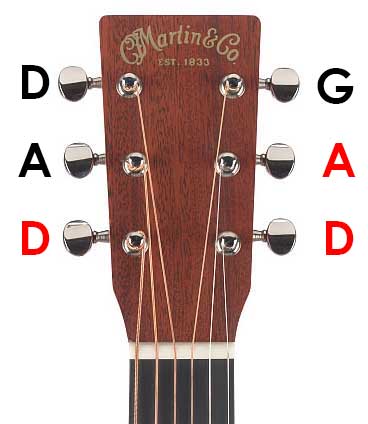
You only need to change the tuning of three strings (highlighted in red) to change from Standard Tuning to DADGAD Tuning. So this is a good tuning to try out if you want to experiment with alternate tunings.
String Tension in DADGAD Tuning
Every time you change to a different tuning, the tension on your guitar strings will change.
This is important to remember because a change in string tension changes how comfortable your guitar feels to play. Changing to a different string tension can also change your guitar neck’s relief.
The good thing about DADGAD Tuning is that you only tune three strings down in pitch. This means you’re not adding more tension to your guitar neck.
You may notice a slight decrease in string tension on the changed strings, but it’s not going to be a big enough change for you to switch to different string gauges.
But if you want to permanently keep your guitar in DADGAD Tuning, you may find that you prefer changing the string gauge on all or some of the strings.
Read this guide on Guitar Strings to learn more about string gauge and tension.
DADGAD Tuning Chords
Here are some basic open chord shapes you can use in DADGAD Tuning:
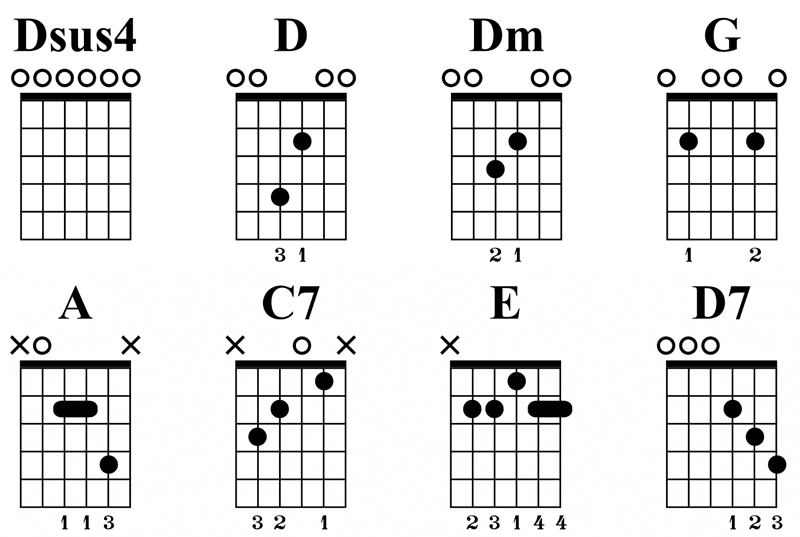
The first chord shown, Dsus4, is what the strings are tuned to in DADGAD Tuning. This means you could call DADGAD Tuning ‘Open Dsus4 Tuning’. Some guitarists may call this tuning ‘Open Dsus4’, but most guitarists know this tuning as ‘dad-gad’.
Note: I have seen a lot of chord diagrams online for D Major chords in DADGAD Tuning that are wrong. A chord is only D Major if it includes the notes: D F# A. Many of the diagrams I have seen used chord shapes that did not use the note F#. The note F# is what makes a D chord a D Major chord.
Moveable Chord Shapes
Some of the above chord shapes can be moved up the fretboard as barre chords. Moveable chord shapes are one of the reasons why open tunings like DADGAD can be so versatile.
Here are some examples of taking a chord shape and moving it up the fretboard to form new chords:
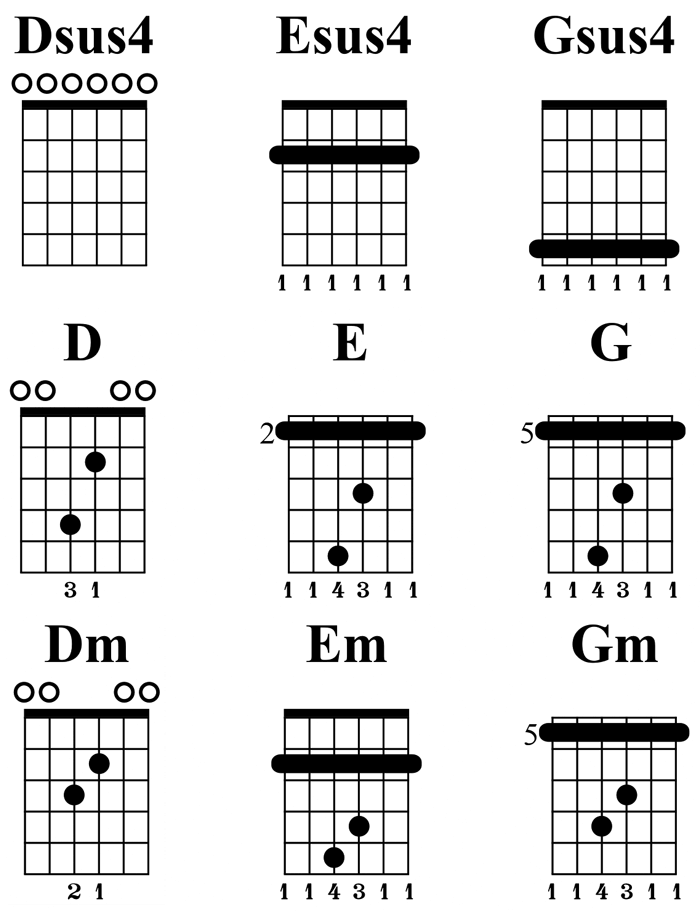
Practice finding new chord positions by taking these chord shapes and moving them up the fretboard. Take note of the root note positions to figure out what the new chord shapes will be. Use the fretboard diagram shown later as a reference to help you.
DADGAD Tuning Fretboard Diagram
Memorizing the notes on the fretboard in DADGAD Tuning is quick and easy if you already know the notes in Standard Tuning.
Three of the strings stay exactly the same and the other three strings match the other strings. There are three D strings, two A strings, and a G string. That makes this tuning incredibly simple to memorize. All you need to do is get used to the order of the strings.
Read this guide on how to Memorize the Notes on the Fretboard to learn effective memorization methods for any tuning.
Here are the notes on the fretboard in DADGAD Tuning:
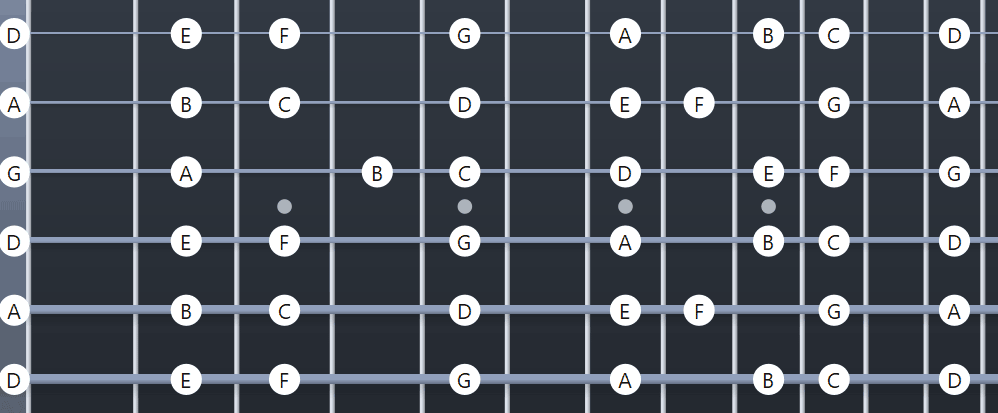
Notice how the notes line up across the strings on the 2nd, 5th, 7th, 10th, and 12th frets. The fact that so many note positions line up so well makes this an excellent tuning to experiment with a guitar slide.
Check out this lesson to learn how to use a guitar slide.
The above fretboard diagram shows you the notes in the C Major Scale. It’s a good scale to memorize as a starting point, but the D Major Scale tends to be more commonly used in DADGAD Tuning.
Here is the D Major Scale in DADGAD Tuning:
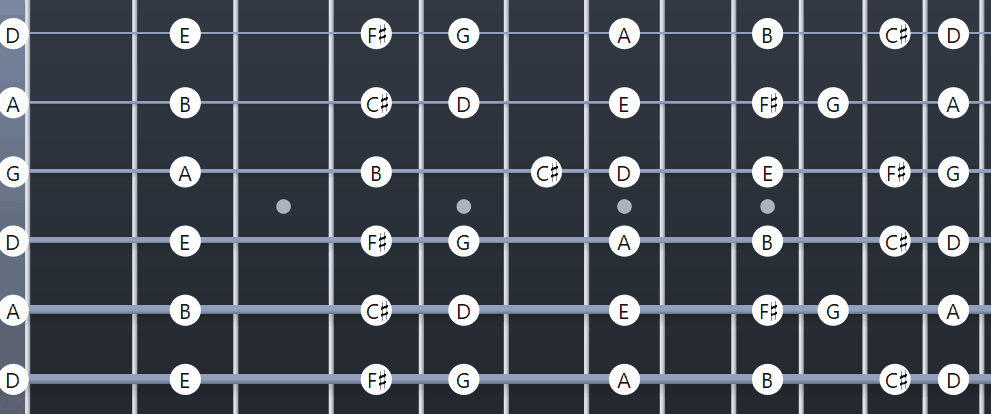
Try writing some riffs or chord progressions using the above fretboard diagram as a reference.
A good exercise is to take a riff or chord progression you know from another song and figure out how to play it in DADGAD Tuning.
Some riffs and chord progressions you know from Standard Tuning will be difficult or awkward to play in DADGAD Tuning, while others will be fine. This is a great way to learn what works and what doesn’t work in this tuning.
Once you learn what types of riffs or progressions work well in this tuning, try coming up with your own riffs or licks. Then you can spend some time improvising with a backing track or writing songs.
DADGAD Tuning Songs (With Guitar TAB)
Here are some well-known songs in DADGAD Tuning. DADGAD Tuning is also known as Celtic Tuning, so you can find a lot of Celtic music in DADGAD Tuning.
Kashmir by Led Zeppelin
There are a few Led Zeppelin songs in DADGAD Tuning and Kashmir is a great one to learn first.
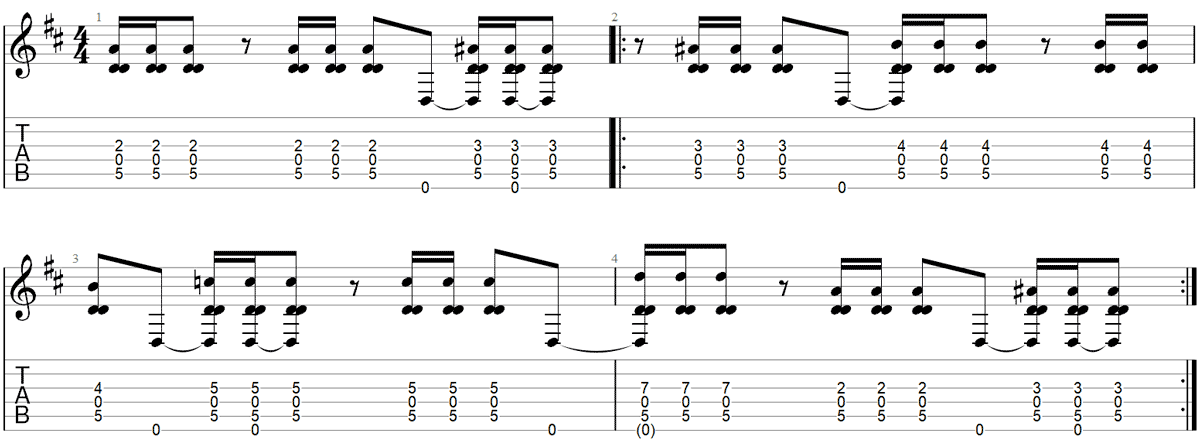
The above riff can be played in Drop D Tuning in the exact same way. So the above riff doesn’t give the best example of this tuning compared to the rest of the song. But it’s a fun riff to play, so give it a go.
Here is an interesting chord-based riff from later in the song that does give a good example of what DADGAD Tuning sounds like:

Try to figure out the optimal finger placement for these chords. You want the chords to flow smoothly from one position to the next. These two chord shapes are a great example of how you can take a chord shape and move it around the fretboard.
There are a few strumming sections in the song that use simple chord shapes. The chords used are incredibly simple thanks to the way the strings are tuned.
After you play around with Kashmir, check out Black Mountain Side for another Led Zeppelin song in DADGAD Tuning.
Dear Maria, Count Me In by All Time Low (Acoustic)
When All Time Low perform this song live on acoustic, they switch to using DADGAD Tuning.
The original song was recorded in Drop D Tuning, so this acoustic version shows how you can take a song and give it a new life by switching to a different tuning.
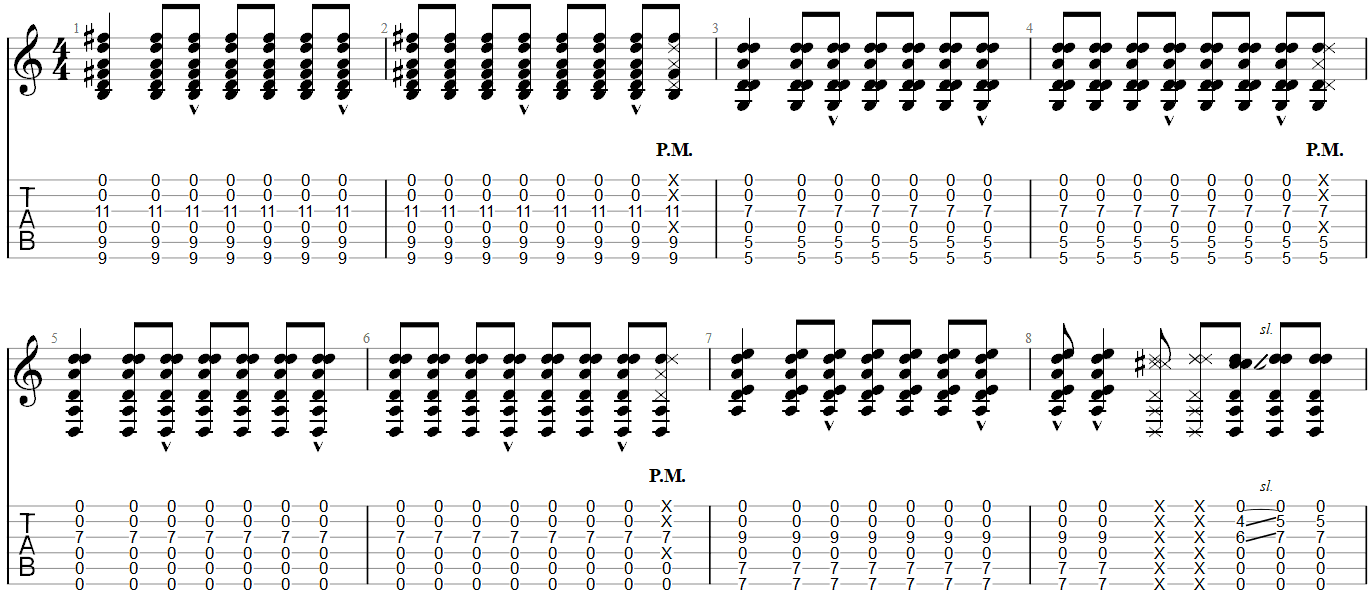
This is a simple song to use that makes use of basic rhythm patterns.
Notice how all of the chord shapes use a few open strings. This is how you get the best sounding chords in an open tuning. If you try coming up with your own chord-based songs, try incorporating as many open strings as you can into each chord.
In Dreams by Ben Howard
This fast-paced and lively song makes great use of DADGAD Tuning and showcases why it’s such a popular tuning with some guitarists.

This song uses fingerpicking, so check out this lesson on Fingerpicking to learn more if you haven’t tried this before. The lesson covers some basic fingerpicking patterns to practice before you move on to more complex patterns like the ones used in this song.
Combining slides, hammer-ons, and pull-offs are simple ways you can spice up any fingerpicking-based songs. You can see throughout this song how these techniques are used. Try playing the above part without any slides or pull-offs and you’ll hear how those techniques change the feel of what you’re playing.
There are some beautiful-sounding chords used throughout this song, so even if you don’t normally play fingerpicking, check out the song to learn new chord shapes.
Here is a section of the song that uses some great-sounding chords:

Notice how some of the best sounding chords in DADGAD Tuning make use of a lot of open strings. Keep this in mind when trying to find new chord shapes.
Try strumming the above chord shapes and you may notice that they sound slightly different. Some chords sound best when strummed, while others sound best when played fingerstyle. If you want to learn why, learn about melodic vs harmonic intervals.
Drifting by Andy McKee
If you’re up for a challenge, check out this song that combines two-hand tapping, percussive hits, and natural harmonics.
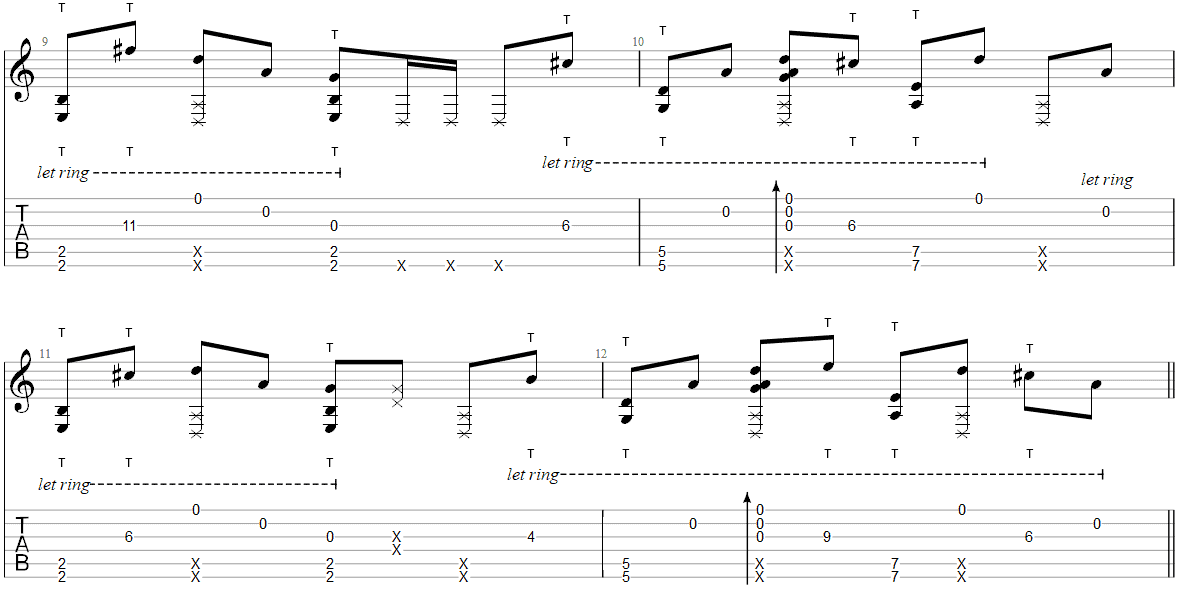
The above Guitar TAB may look a bit strange because this song isn’t played in a conventional way. Your fretting hand plays the partial chords on the lower strings and your picking hand plays most of the higher string parts using tapping.
The best way to understand how to play this song is to watch Andy perform it in this video:
If you’re wondering why his guitar has a slanted fretboard in the above video, check out this Guide on Fanned Frets. The guide explains what the big deal is with fanned frets (also known as multiscale guitars). Keep in mind that you don’t need a multiscale guitar to play this song.
This song may be too advanced for many guitarists reading this guide, but it’s a great example of how DADGAD Tuning can open up new ideas and change the way you think about playing guitar.
Another great example of two-hand tapping and percussive rhythms in a song using DADGAD Tuning is Knock on Wood by Justin King. If you want to work on your hammer-ons and tapping, it’s a great workout.
I talk about how you can use alternate guitar tunings as a way to shake up your playing in this podcast episode.
DADGAD Tuning FAQ
Here are some common questions you might have about DADGAD Tuning:
What is DADGAD Tuning Good For?
DADGAD Tuning is good for Celtic music but can be used in folk, rock, blues, or other styles. Open tunings are often used by acoustic guitarists to form interesting chords that would be awkward in Standard Tuning.
What is DADGAD Tuning Called?
DADGAD Tuning is pronounced “dad-gad” and is sometimes called ‘Celtic’ tuning or ‘Open Dsus4’ Tuning. Most guitarists call this tuning dad-gad, while guitarists who play a lot of Celtic music call this tuning Celtic tuning. It’s sometimes called ‘Open Dsus4’ Tuning due to the chord formed on the open strings.
Is DADGAD Tuning Bad For Your Guitar?
DADGAD Tuning is not bad for your guitar. Changing from Standard Tuning to DADGAD Tuning slightly reduces the tension on the neck, which will not cause any problems.
It is perfectly safe for your guitar to tune it to DADGAD Tuning.
Is DADGAD Tuning an Open Tuning?
DADGAD Tuning is an open tuning because it forms a Dsus4 chord across the open strings. A Suspended fourth chord is neither Major nor minor, so DADGAD Tuning isn’t a Major or minor open tuning.
Is DADGAD Easier?
DADGAD Tuning is easier to learn compared to some other open tunings because only three strings are changed from Standard. This means you may find it easier to feel comfortable with the change in tuning as you will already know most of the note positions.
Check out this Ultimate Guide to Alternate Tunings to try out some other open tunings.
